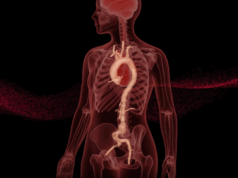
The updated European Society for Vascular Surgery (ESVS) 2024 clinical practice guidelines for the care of patients with aneurysms of the abdominal aorta and iliac arteries have been published online this month in the European Journal of Vascular and Endovascular Surgery, and will be in print next month. Here, Anders Wanhainen (Uppsala, Sweden) and Isabelle Van Herzeele (Ghent, Begium)—chair and co-chair of the guideline writing committee, respectively—highlight some important updates from the new document for vascular specialists and policy makers alike.
The ESVS 2024 guidelines document on the management of abdominal aortoiliac artery aneurysms was developed over a three-year period by a writing committee comprising of 16 aortic experts from 12 European countries. By summarising and evaluating the currently best available evidence, 160 recommendations for the evaluation and treatment of patients have been formulated and graded according to a modified European Society of Cardiology grading system, where the strength (class) of each recommendation is graded from I to III and the letters A to C to mark the level of evidence (LoE). Compared to the previous 2019 version, 59 recommendations are completely new, 49 have been revised, and only 52 recommendations have not been changed. Importantly, only 10/160 (6%) recommendations are based on Level A evidence, while 112 (70%) recommendations are supported by Level C evidence or based on consensus, illustrating lack of evidence in the aortic field.
Screening and management of small AAAs
Because of changing epidemiology, with the decreasing prevalence of abdominal aortic aneurysm (AAA), a thorough re-evaluation of the screening recommendations has been made. Although screening of high risk groups remains highly recommended (Class I, Level A), the target groups have not been included in the recommendations, but should be made depending on local conditions, such as prevalence of the disease, life expectancy and healthcare structure.
People who have first-degree relatives with AAA, with other peripheral aneurysms or organ transplant recipients are established high-risk groups that should be subject to screening. Older men, especially those with a history of smoking, also remain a suitable target group in many settings. But in populations with extremely low smoking prevalence, the incidence of AAA is so low (<1%) that the value of screening can be questioned. There is also lack of support for screening women and people with cardiovascular disease.
The importance of cardiovascular risk factor management in patients with small AAAs has been strengthened. Based on a comprehensive analysis of the available evidence it is not considered to be justified to restrict the use of fluoroquinolone antibiotics in patients with AAA as was previously suggested by the US Food and Drug Administration (FDA) and European Medicines Agency (EMA). Similarly, this guideline advises against restricting exercise and sexual activity in patients with AAAs.
Indication for repair
In line with the evidence, a clear negative recommendation is now issued for the repair of AAA <55mm in men and <50mm in women. The diameter threshold for when repair can be considered is maintained at 55mm for men and 50mm for women; however, the recommendations have been downgraded due to the lack of supporting high quality evidence. Furthermore, in line with recent data, it is clarified that the diameter threshold for considering repair should preferably be based on the ultrasound (US) measurement, while computed tomography angiography (CTA) for treatment planning is only recommended when the diameter threshold has been met on US.
Given the natural history of iliac artery aneurysms with slow growth rates and the very low risk of rupture below 40mm in diameter, the writing committee considers it justified to raise the recommended diameter threshold for surgical repair to 40mm. There are no data to suggest any gender differentiation of the indication for repair. Nevertheless, it may be reasonable to take gender and body size into account, in the same way as for AAA.
Elective AAA repair
Due to the rapid technological and medical development, the existing RCTs comparing open surgical repair (OSR) and endovascular aneurysm repair (EVAR) are partly outdated and thereby not entirely relevant for today’s situation. It is therefore necessary to also include more recent case series and register studies in the overall evaluation. Thus, despite data from multiple RCTs and meta-analyses, representing the highest level of evidence, the existing level of evidence was rated as mediocre (Level B). Overall, evidence suggests a significant short-term survival benefit of EVAR over OSR, with similar long-term outcome up till 15 years of follow-up. Thus, the impetus towards EVAR as the preferred treatment modality for AAA in most patients is retained in the 2024 guideline.
Following reports of failing devices in EVAR, this guideline advocates the use of devices with proven durability, and advises against EVAR outside the manufacturer’s instruction for use (IFU) in the elective setting. Long-term follow up in prospective registers of updated devices based on established platforms is recommended as before, however with the increased requirement for 10 years of durability data.
Due to the lack of evidence of a clinically relevant benefit, routine pre-emptive coiling of side branches or non-selective aneurysm sac embolisation before EVAR is not recommended, and in OSR of AAA routine use of antimicrobial coated grafts to prevent aortic graft infection is not recommended.
The previously preferred endovascular approach for iliac aneurysms has been amended. Neither technique is generally considered superior to the other, but instead the choice of surgical technique (open or endo) for iliac aneurysm repair should be based on patient and lesion characteristics.
Ruptured AAA repair
The benefit of EVAR for rAAA has been demonstrated in RCTs and large cohort studies, which is why the recommendation for EVAR as the first option in rAAA remains as Class I, whereas it is considered justified to upgrade the LoE to Level A.
The recommendation of using aortic balloon occlusion for proximal control is downgraded due to the uncertainty of its effect, while the recommendation for vacuum assisted open abdominal closure has been upgraded, with the addition of mesh traction. Other news includes the need for proper stent graft oversizing, anticoagulation in the emergency setting, management of colonic ischaemia, and treatment of aorto-caval fistula.
EVAR follow-up
An updated recommended follow-up algorithm after standard EVAR has been included. All patients are recommended for early post-operative CTA imaging (within 30 days), to assess the presence of endoleak, component overlap and sealing zone length.
Patients stratified as low risk of complications (no endoleak, anatomy within IFU, without high risk features (proximal neck diameter <30mm and angulation <60°, and iliac diameter <20mm), adequate overlap and seal of ≥10mm proximal and distal stent graft apposition to arterial wall) should be considered for low frequency imaging follow-up during the first five years.
Patients deemed at high risk (presence of type 2 endoleak [T2EL], insufficient overlap or seal <10mm, anatomy outside IFU, large proximal neck (>30mm), ectatic iliac fixation zones (>20mm) or extreme angulation (>60°) and EVAR failures (direct endoleak [type 1 or 3 endoleak], obvious degradation of seal zones with impending endoleak, or aneurysm sac growth > 10mm) should instead be managed more actively with intensified and/or additional imaging or consideration of treatment.
Several new and updated recommendations on the management of endoleaks are presented and a suggested diagnostic step up for occult undetermined endoleaks is described, where the option of conversion to open surgical repair (OSR) with stent graft explantation is highlighted.
Complex AAA
The coverage of complex AAAs has been expanded significantly to reflect advances in technology since 2019 and now covers the management of juxta- and pararenal AAAs as well as suprarenal AAAs and type 4 thoraco-abdominal aortic aneurysms (TAAAs). Treatment recommendations have been updated based on an increasingly comprehensive body of knowledge, including preliminary data from the most recent UK Complex aneurysm study (UK COMPASS trial). Endovascular repair with fenestrated and branched endografts is considered to have some benefit and is advocated in patients with high surgical risk and complex anatomy.
Further updated recommendations have been issued on preservation of renal function, prevention of spinal cord ischaemia, and new technologies, such as off the shelf branched devices, physician modified fenestrated endografts (PMEGs), and in situ fenestration. Parallel graft techniques should only be considered as an option in the emergency setting, or as a bailout, and ideally be restricted to ≤2 chimneys. The use of new techniques and concepts for treatment of complex AAAs is not recommended in routine clinical practice, and should be limited to studies approved by research ethics committees after obtaining patient’s informed consent, until adequately evaluated. Of note, this includes the use of endostaples to treat short- neck AAAs with standard EVAR devices.
Centralisation
The firm evidence of a volume-outcome relationship of surgical repair in general, and AAA repair in particular, makes it necessary and justifiable with a continued centralisation of AAA repair. The recommended minimum yearly caseload has been upgraded to at least 30 standard AAA repairs per centre (no less than 15 of each OSR and EVAR), and a consensus recommendation on a minimum yearly caseload of 20 complex AAA repairs has been added. Rare and complex conditions, such as aortic graft infections, mycotic aortic aneurysms and patients with genetic syndromes should only be managed in highly specialised centres.
Conclusion
We encourage everyone to carefully read the new ESVS aortic guidelines in its entirety. We realise that it is an extensive document but it offers more recommendations of clinical importance and a comprehensive supporting text summarising the literature and motivating our positions. We hope you will find it relevant and useful for your practice.
Anders Wanhainen is professor and chair of vascular surgery at Uppsala University in Uppsala, Sweden.
Isabelle Van Herzeele is associate professor of vascular surgery in the Department of Thoracic and Vascular Surgery at Ghent University in Ghent, Belgium.













